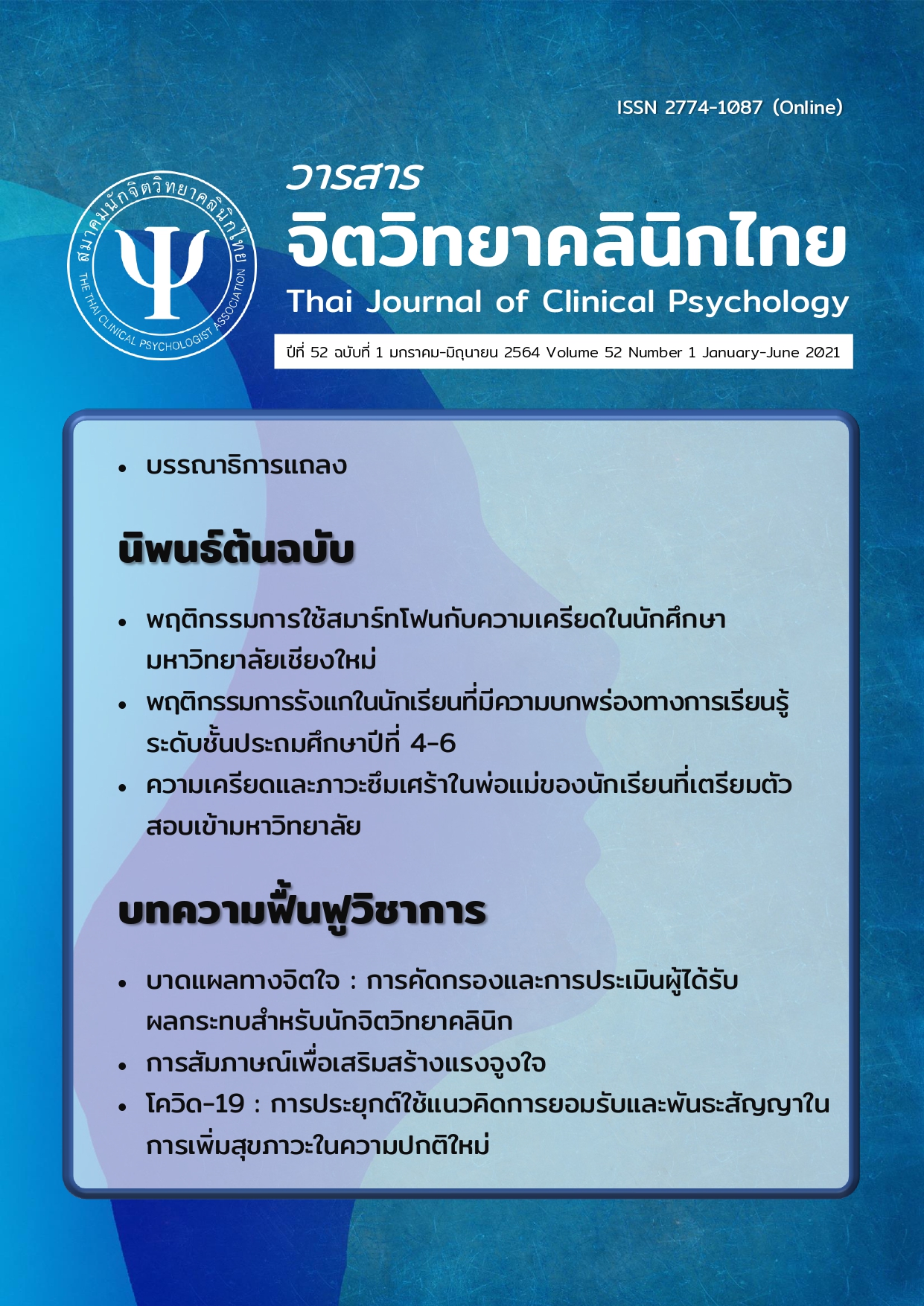พฤติกรรมการรังแกในนักเรียนที่มีความบกพร่องทางการเรียนรู้ระดับชั้นประถมศึกษาปีที่ 4-6
Main Article Content
บทคัดย่อ
วัตถุประสงค์ เพื่อศึกษาพฤติกรรมการรังแกในนักเรียนที่มีความบกพร่องทางการเรียนรู้ระดับชั้นประถมศึกษาปีที่ 4-6 วัสดุและวิธีการ เครื่องมือที่ใช้คือ 1) แบบทดสอบความสามารถทางสติปัญญา Standard Progressive Matrices; parallel version 2) แบบคัดกรองนักเรียนที่มีภาวะสมาธิสั้น บกพร่องทางการเรียนรู้ และออทิสซึม (KUS-SI Rating Scales) 3) แบบสอบถามพฤติกรรมการรังแกนักเรียนที่มีความบกพร่องทางการเรียนรู้ระดับประถมศึกษาปีที่ 4-6 ผลการศึกษา จากการศึกษาพบว่าพฤติกรรมการรังแกนักเรียนที่มีความบกพร่องทางการเรียนรู้ระดับประถมศึกษาปีที่ 4-6 เพศชายและเพศหญิงมีพฤติกรรมการรังแกของผู้ถูกรังแกแตกต่างกันในด้านวาจาอย่างมีนัยสำคัญทางสถิติที่ระดับ .05 แต่ไม่พบความแตกต่างของพฤติกรรมการรังแกด้านวาจา ร่างกาย และสัมพันธภาพในผู้รังแกและผู้ถูกรังแกระหว่างเด็กที่มีความบกพร่องทางการเรียนรู้กับเด็กปกติ
Article Details
เรื่องที่ลงตีพิมพ์ในวารสารจิตวิทยาคลินิกแล้วถือเป็นลิขสิทธิ์การเผยแพร่โดยวารสารจิตวิทยาคลินิกแต่เพียงผู้เดียว การตีพิมพ์หรือเผยแพร่ซ้ำในที่อื่นต้องได้รับอนุญาตจากกองบรรณาธิการวารสารฯ
เอกสารอ้างอิง
Boyle, D. J. (2005). Youth bullying: Incidence,impact, and interventions. Journal of
the New Jersey Psychological Association, 55, 22-24.
Cheng, Y., Newman, I. M., Qu, M., Mbulo, L.,Chai, Y., Chen, Y. & Shell, D. F. (2009).
Being bullied and psychosocial adjustment among middle school students in China. Journal of School Health, 80(4). 227-243.
Child and Adolescent Mental Health Rajanakarindra Institute (CAMRI). (2018) . A practical guide for action prevents and manage bullying in schools. Department of Mental Health. Bangkok, 1-7. (in Thai).
Conti-Ramsden, G., & Botting, N. (2004). Social difficulties and victimization in
children with SLI at 11 years of age. Journal of Speech, Language, and
Hearing Research, 47(1), 145-161.
Crick, N. R., Nelson, D. A., Morales, J. R., Cullerton-Sen, C. Casas, J. F., &
Hickman, S. E. (2001). Relational victimization in childhood and adolescence: I hurt you through the grapevine. [research gate]. Retrieved
from https://www.researchgate.net/publication.
Dechothanawat C. (2011). The problem of bullying, intimidation, and depression
in high school students in grade 1-3 of a government school in Bangkok Noi.
Bangkok (Doctoral dissertation). Mahidol University. Bangkok. (in Thai).
Department of Mental Health. (2016). Subject: Department of mental health suggests 5 prevention 5 stop to reduce the problem of children pretending to be.
[information]. Retrieved from: http://www.forums.dmh.go.th (in Thai).
Gonç alves, F. G., Heldt, E., Peixoto, B. N., Rodrigues, G. A., Filipetto, M., &
Guimarães, L. S. P. (2016). Construct validity and reliability of Olweus bully/victim questionnaire-Brazilian version.Psicologia: Reflexã o e Crí tica, 29(27). 1-8.
Great Schools Staff. (2016). Understanding bullying and its impact on kids with
learning disabilities or ADHD. [weblog]. Retrieved from http://www.greatschools.org/.
Hamburger, M. E., Basile, K. C., & Vivolo, A. M. (2011). Measuring bullying victimization,perpetration, and bystander experiences: A compendium of assessment tools. Atlanta, GA: Centers for Disease Control and Prevention, National Center for Injury Prevention and Control.
Kaukiainen, A., Salmivalli, C., Lagerspetz, K., Tamminen, M., Vauras, M., Mäki, H., &
Poskiparta, E., (2002). Learning difficulties, social intelligence, and
self-concept: Connections to bullyvictim problems. Scandinavian Journal
of Psychology, 43(3). 269-278.
Kuhne, M. & Wiener, J. (2000). Stability of social status of children with and without
learning disabilities. Learning Disability Quarterly, 23(1). 64-75.
Laeheem, K. (2014). Factors related to students’ bullying behavior in Islamic
private schools, Songkhla Province. Srinakharinwirot Research and
Development (Journal of Humanities and Social Sciences), 6(12), 14-30.
(in Thai).
Marcum, C. D., Higgins G. E., Freibuge, T. L., & Ricketts. M. L. (2012) . Battle of
the sexes: An examination of male and female cyber bullying. International
Journal of Cyber Criminology, 6( 1), 904-911.
Martlew, M, & Hodson J. (1991). Children with mild learning difficulties in an
integrated and in a special school: comparisons of behavior, teasing
and teachers' attitudes. The British Journal of Educational Psychology,
(3). 372-355.
McMahon, E. M., Reulbach, U., Keeley, H., Perry, I. J., & Arensman, E. (2010).
Bullying victimization, self-harm, and associated factors in Irish adolescent
boys. Social Science & Medicine, 71(7). 1300-1307.
Puranachaikere, T., Punyapas, S., & Kaewpornsawan. T. (2015). Coping
strategies of grade 4-6 primary school students in response to being
bullied. Journal of the Psychiatric Association of Thailand, 60(4). 275-
(in Thai).
Pruksapanachart, B. (2011). The relationship between bullying behavior and
self-esteem in attention deficit /hyperactivity disorder patients. Journal
of Psychiatric Association of Thailand, 56(2). 93-102.
Raven, J., Raven, J. C., & Court, J. H. (2004). Manual for Raven's progressive
matrices and vocabulary scales. section 3: The standard progressive matrices. San Antonio, TX: Harcourt Assessment.
Rayle, A. D., Moorhead, H. J. H., Green, J., Griffin, C. A. & Ozimek, B. (2007) .
Adolescent girl-to-girl bullying: Wellness-based interventions for school counselors. Journal of School Counseling, 5(6).1-36.
Rotemanunthakrit, N. (2013). Cross-cultural communication behaviors and schoolbullying (Master’s thesis). Chulalongkorn University, Bangkok. (in Thai).
Sakarinkhul, C. & Wacharasindhu, A. (2014).
Prevalence of bullying and associated psychosocial factors among lower
secondary school students in Muang, Chiangmai Province. Journal of the
Psychiatric Association of Thailand, 59(3). 221-230. (in Thai).
Tapanya S. (20 0 7 ) . Study to develop a sustainable violence prevention model
in children. National health foundation supported by Thai health promotion
foundation. (in Thai).
Thongtanongsak, P. (2 0 1 7 ) . A study of bullying behavior of lower secondary
school students at Nong Khaem district school under the department of
education, Bangkok. Ramkhamhaeng University. Thailand. (in Thai).
van Geel, M., Vadder, P., & Tanilon, J. (2014). Bullying and weapon carrying: a meta-analysis. JAMA Pediatrics, 168(8). 714-720.
Vibulpatanavong, K. (2017). Attitudes of upper primary school students towards peers with specific learning disability. Journal of Research and Development in
Special Education Research and Development, 6(2), 8-20. (in Thai).
Uthairattanakit, D., & Phornnopadon et al. (2006). KUS-SI rating scales: ADHD/
LD/ Autism (PDDs). National Research Council of Thailand (NRCT). (in Thai).
Volk, A. A., Farrell, A. H., Franklin, P., Mularzyk, K. P., & Provenzano, D. A. (2016).
Adolescent bullying in schools: An evolutionary perspective. In D. Geary
and D. Berch (Eds.), Evolutionary perspectives on child development and
education (pp. 167-191). Switzerland: Springer International Publishing.
Yodprang, B. (2007). Bullying among lower secondary school students in Pattani
Province (Master’s thesis). Prince of Songkla University, Pattani. (in Thai).
Zhang, A., Musu-Gillette, L., & Oudekerk, B. A. (2016). Indicators of school crime and safety: 2015. Washington, DC.: National Center for Education Statistics, U.S.
Department of Education, and Bureau of Justice Statistics, Office of Justice
Programs, U.S. Department of Justice.
Zhang, W., Gu, C., Wang, M., Wang, Y., & Jones, K. (2000). Gender differences
in the bully/victim problem among primary and junior middle school
students. Psychological Science (China), 23(4), 435-439.


